FROM THE GIVEN TRANSFORMATION FIND THE QUADRATIC FUNCTION
Subscribe to our ▶️ YouTube channel 🔴 for the latest videos, updates, and tips.
Problem 1 :
Write a quadratic equation with a minimum that has been shifted 5 units to the right and 7 units down from the parent function.
Solution:
Parent function y = x2
Horizontal translation:
Shifted 5 units to the right.
y = (x - 5)2
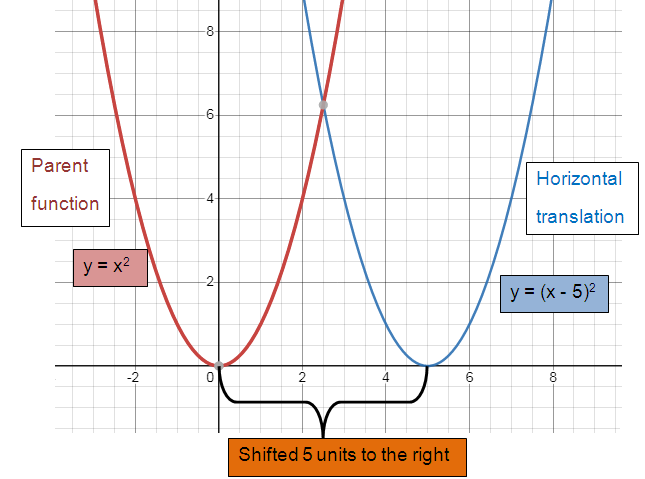
Vertical translation:
Shifted 7 units to the down.
y = (x - 5)2 - 7
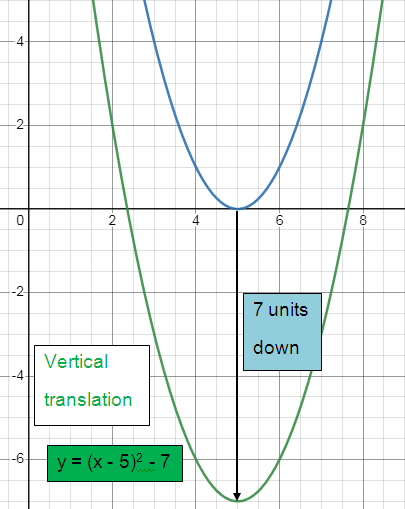
Problem 2 :
Write a quadratic equation with a maximum that has been shifted 4 units to the left and 3 units up from the parent function.
Solution:
Parent function y = x2
Horizontal translation:
Shifted 4 units to the left.
y = -(x + 4)2
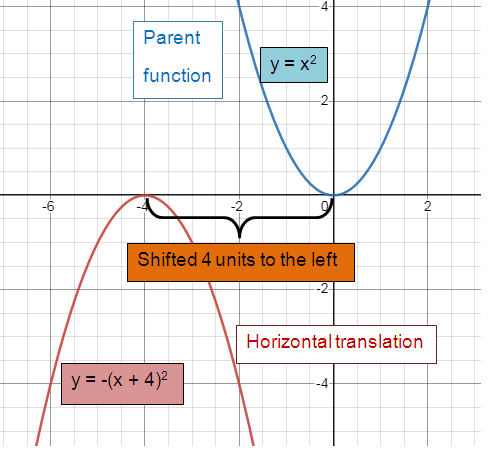
Vertical translation:
Shifted 3 units to the up.
y = -(x + 4)2 + 3
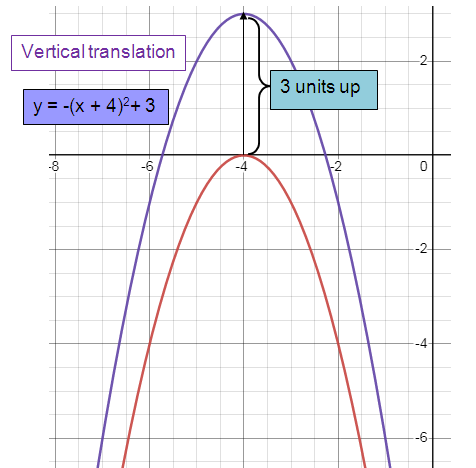
Problem 3 :
Write a quadratic equation with a maximum that has been shifted 2 units to the right and 1 units down from the parent function.
Solution:
Parent function y = x2
Horizontal translation:
Shifted 2 units to the right.
y = -(x - 2)2
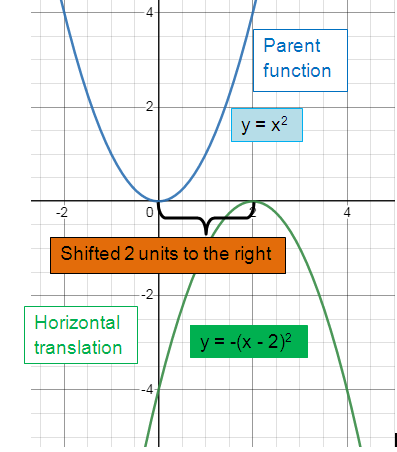
Vertical translation:
Shifted 1 unit to the down.
y = -(x - 2)2 - 1
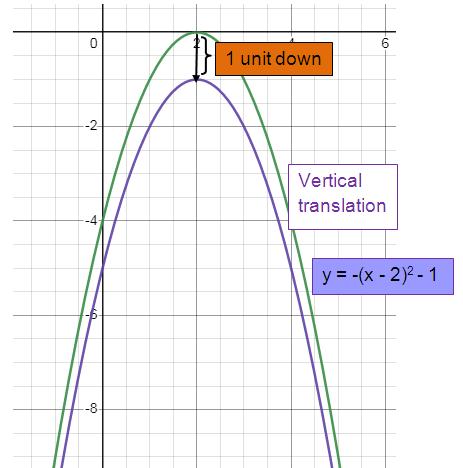
Problem 4 :
Write a quadratic equation with a minimum that has been shifted 5 units to the left and 6 units down from the parent function.
Solution:
Parent function y = x2
Shifted 5 units to the left and 6 units down.
y = (x + 5)2 - 6
Problem 5 :
What is the equation of this graph?
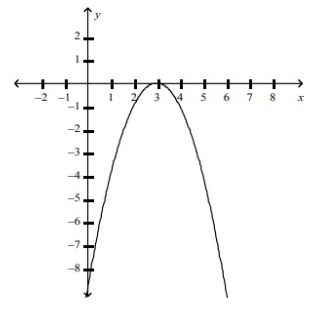
a. y = -x2 + 3 b. y = -3x2 c. y = -(x + 3)2
d. y = -(x - 3)2
Solution:
In the above graph, shifted 3 units to the right and no vertical movement from the parent function. So,
y = -(x - 3)2
So, option (d) is correct.
Problem 6 :
Which function includes a translation of 3 units to the left?
a. f(x) = (x + 3)2 + 1 b. f(x) = 3x2 + 1
c. f(x) = (x - 3)2 + 1 d. f(x) = (x + 1)2 - 3
Solution:
Parent function y = x2
Translation of 3 units to the left
f(x) = (x + 3)2
So, option (a) is correct.
Problem 7 :
Which equation shows a translation of 3 left and vertical compression by a factor of 2 to the graph of y = x2 ?
Solution:
a. y = 2(x - 3)2 b. y = 2(x + 3)2
Solution:
Parent function y = x2
After translation
y = 2(x + 3)2
So, option (b) is correct.
Problem 8 :
Which equation describes a parabola that opens downward, is congruent to y = x2, and has its vertex at (0, 3)?
a. y = (x + 3)2 - 1 b. y = -x2 + 3
c. y = -(x - 3)2 d. y = x2 + 3
Solution:
vertex (0, 3)
a.
y = (x + 3)2 - 1
when x = 0, y = 8
b.
y = -x2 + 3
when x = 0, y = 3
c.
y = -(x - 3)2
when x = 0, y = -9
d.
y = x2 + 3
when x = 0, y = 3
It is congruent to y = x2.
So, option (d) is correct.
Problem 9 :
List the sequence of steps required to graph the function
f(x) = -(x + 4)2 - 6
a. Horizontal translation 4 units to the right, vertical compression by a factor of 1, vertical translation 6 units down.
b. Horizontal translation 4 units to the right, reflection in x-axis, vertical translation 6 units down.
c. horizontal translation 4 units to the left, vertical translation 6 units up, reflection in x-axis.
d. horizontal translation 4 units to the left, reflection in x-axis, vertical translation 6 units down.
Solution:
f(x) = -(x + 4)2 - 6
Parent function y = x2
Shift 4 units to the left, reflect across the x-axis, shift 6 units downwards.
So, option (d) is correct.
Problem 10 :
Which function matches the graph?
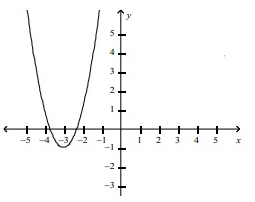
a. f(x) = -2(x - 3)2 + 1 b. f(x) = 2(x + 3)2 - 1
c. f(x) = (x + 3)2 + 2
Solution:
In above graph, horizontal translation 3 units to the left, vertical compression by a factor of 2, vertical translation 1 unit down.
f(x) = 2(x + 3)2 - 1
So, option (b) is correct.
Problem 11 :
Consider a parabola P that is congruent to y = x2, opens upward, and has vertex (-1, 3). Now find the equation of a new parabola that results if P is reflected in the x-axis and translated 3 units down.
a. y = -(x + 4)2 + 3 b. y = (x - 1)2 + 6
c. y = -(x + 1)2 d. y = -(x - 2)2 + 3
Solution:
Parent function is y = x2
Opens upward and it has vertex (-1, 3).
y = (x - (-1))2 + 3
y = (x + 1)2 + 3
Reflection across the x-axis. Then put y = -y
y = -(x + 1)2 + 3
Translating 3 units down :
y = -(x + 1)2 + 3 - 3
y = -(x + 1)2
So, option c is correct.
Subscribe to our ▶️ YouTube channel 🔴 for the latest videos, updates, and tips.
Recent Articles
-
Finding Range of Values Inequality Problems
May 21, 24 08:51 PM
Finding Range of Values Inequality Problems -
Solving Two Step Inequality Word Problems
May 21, 24 08:51 AM
Solving Two Step Inequality Word Problems -
Exponential Function Context and Data Modeling
May 20, 24 10:45 PM
Exponential Function Context and Data Modeling